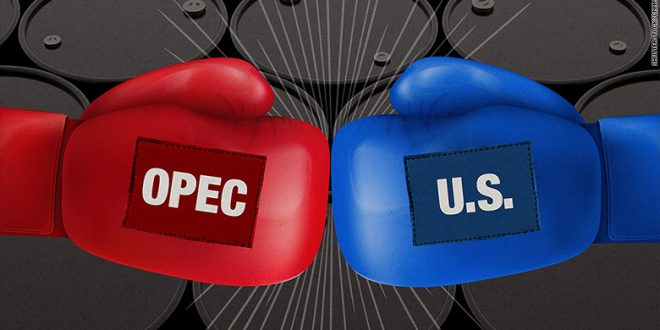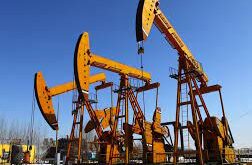For almost three decades. OPEC has always pumped at least 30% of the world’s crude oil. creating an informal floor for Saudi Arabia and its allies in the cartel. The level has survived everything from wars and economic crises to terrorist attacks and diplomatic spats.
Yet. with OPEC set to extend output cuts for the rest of the year and potentially into early 2020. its share of the oil market is all but certain to drop below 30% for the first time since 1991. according to Bloomberg News calculations.
The sliding market share of the Organization of Petroleum Exporting Countries. which meets in Vienna on Monday. highlights how the cartel keeps giving ground to rising U.S. shale production in pursuit of higher prices.
“For Saudi Arabia. the oil policy right now is 100% revenues.“ said Amrita Sen. chief analyst at consultant Energy Aspects Ltd. “But if inventories don’t fall and prices don’t rise. the policy is not sustainable.“
Saudi Arabia and Russia agreed on Saturday to push for an extension of the current OPEC+ production cuts for the rest of the year and potentially all the way to March 2020. making the outcome of next week’s gathering in Vienna of OPEC and non-OPEC oil ministers all but a foregone conclusion.
Bloomberg calculated OPEC’s market share by measuring crude production from the cartel — which is subject to output caps — but not condensates and other natural gas liquids that are excluded from the quotas. Monthly OPEC output was then measured against quarterly global oil demand as estimated by the International Energy Agency.
OPEC nations are bearing the burden of the market-share loss unevenly. Under U.S. sanctions. Tehran and Caracas have seen their production collapse. lightening the effort other members had to make to support high oil prices. Since December. Iranian and Venezuelan output has fallen by almost 1 MMbpd. hitting its lowest level in about 40 years. according to Bloomberg News estimates.
Other OPEC nations have avoided trouble by simply flouting the rules. virtually pumping at will. Iraq. for example. produced 4.7 MMbpd in May. matching a record it set in December. But Saudi Arabia. the group’s most important member. is having to make deeper cuts than initially planned. reducing output recently to 9.7 MMbpd. well below the level of 10.3 MMbpd it agreed with its OPEC partners.
The deeper Saudi cuts show Riyadh is willing to cross previous red lines. Khalid Al-Falih. the Saudi oil minister. said in a speech in 2017 that the kingdom wouldn’t fight a structural change in the market and “bear the burden of free riders.“ warning it wouldn’t cut its output unilaterally.
But the loss of market share shouldn’t be a huge surprise. Ali Al-Naimi. the previous oil minister who ran Saudi oil policy for two decades. warned about the risk soon after his forced retirement. Al-Falih reversed Al-Naimi’s strategy of pump-at-will. designed to curtail the growth of shale production. opting instead to sacrifice market share to lift prices.
“Anybody who thinks he or any country is going to influence the price in today’s environment is out of his mind.“ Al-Naimi told the Financial Times in 2016. “I have no idea why they want a reversal because a high price will definitely bring more crude to the market and OPEC will further lose [market] share.“
With oil-demand growth weakening due to the impact of the U.S.-China trade war and U.S. shale set to grow strongly in the second half of this year and beyond. Saudi Arabia and OPEC face the prospect of extending their cuts into next year or even 2021. deepening the loss of market share still further.
“At a minimum. OPEC has to sustain the present cuts through to the end of 2020.“ said Simon Flowers. chairman of consultant Wood Mackenzie Ltd. “OPEC’s got a tricky job.“
It’s a lower-for-longer oil-production scenario that suggests that OPEC is aiming for a price that’s too high. Although Saudi Arabia shies away from price targets. it needs $70-$80 bbl to meet the kingdom’s fiscal requirements. But by pursuing that price. it’s boosting not just shale. but also deepwater exploration.
According to the International Monetary Fund. Riyadh needs $85 bbl to finance its budget. compared with an average of $78 during the 2000-2015 period.
So far. Riyadh has avoided a reckoning thanks to unusually high demand growth and the help of the American sanctions on Caracas and Tehran. But the longer the cartel keeps production cuts in place. the more evident it becomes that the strategy relies on strong demand. sanctions and outages. Take away one of those elements. and Riyadh will face a difficult choice: cut deep. or accept lower prices.
“OPEC’s balancing act gets harder in face of weak demand.“ said Bassam Fattouh. head of the Oxford Institute for Energy Studies. “OPEC hopes that it does not have to confront this choice anytime soon. though this is beyond its control.“
Riyadh has signaled it would rather lose further market share than embark on another pump-at-will oil policy. Each time that the kingdom has shifted policy toward fighting for market share — in 1986. 1998 and 2014 — oil prices have collapsed.
For now. it has the support of Russia. with President Vladimir Putin announcing on Saturday that he’s agreed with Saudi Crown Prince Mohammed Bin Salman to extend the OPEC+ agreement.
Yet Moscow is starting to worry about the strategy. Since both countries came together in late 2016 to manage the oil market. they have privately disagreed about the ideal level for prices.
Putin brought the conflict into the open in early June. explaining that “there are some disagreements“ between Moscow and Riyadh “that stem from a different understanding of what can be called a fair price.“
Putin went further: “Look at the price per barrel of oil that is used to calculate. say. the budget of Saudi Arabia. It is much higher than what we use. Ours is $40 bbl. and their price is higher. That is why. of course. they want to keep the price higher.“
 Iran Energy News Oil, Gas, Petrochemical and Energy Field Specialized Channel
Iran Energy News Oil, Gas, Petrochemical and Energy Field Specialized Channel




